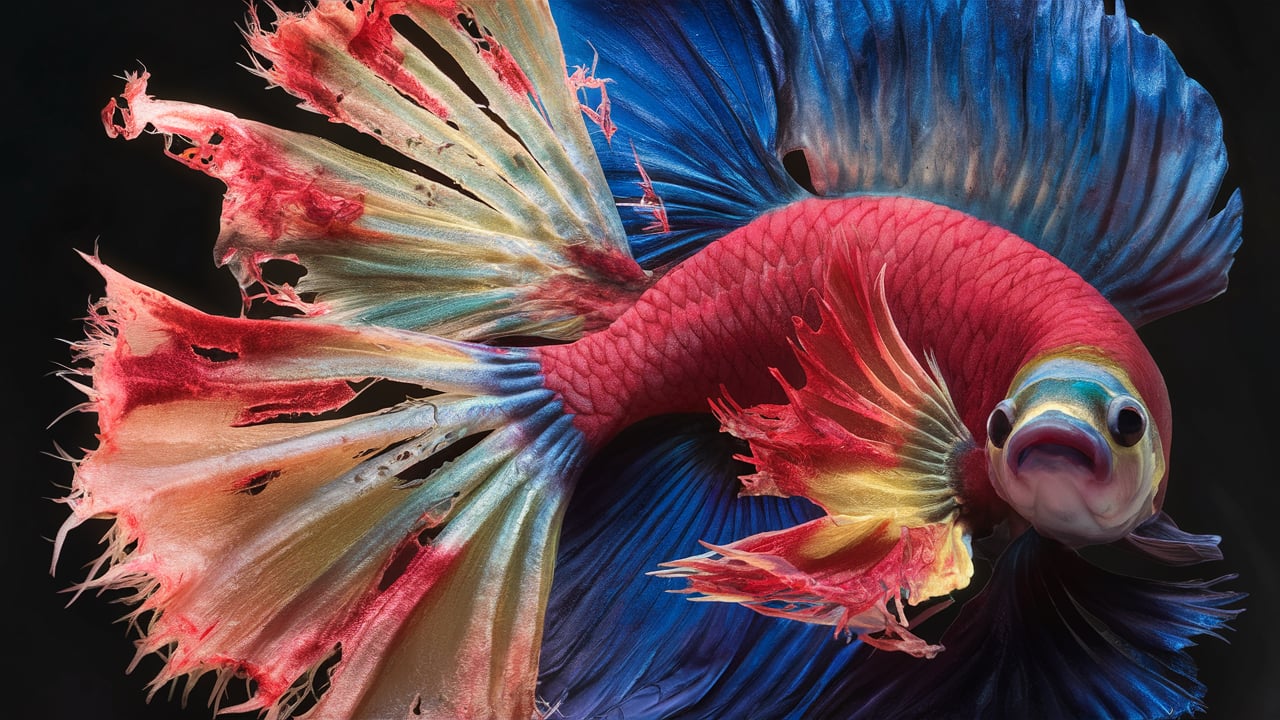Fish are susceptible to health issues, and one of the most common and distressing is Fighting Fish Fin Rot. This guide, brought to you by Koi Fish Tips, will delve into the world of Fighting Fish Fin Rot, providing you with the knowledge and tools to identify, treat, and prevent this condition, ensuring your betta’s fins remain as dazzling as their personality.
Understanding Fighting Fish Fin Rot
Imagine your betta, once a vibrant splash of color, now sporting ragged, discolored fins. This is the telltale sign of Fighting Fish Fin Rot, a bacterial infection that can significantly impact your betta’s health and well-being.
Fin rot is not just an aesthetic issue; it’s a gateway to more serious infections. Damaged fins can make your betta vulnerable to parasites, bacteria, and fungal infections, weakening their immune system and compromising their overall health.
Causes of Fighting Fish Fin Rot: Unraveling the Mystery
Fighting Fish Fin Rot is often triggered by a combination of factors:
- Poor Water Quality: Dirty water, with high levels of ammonia, nitrite, and nitrates, can weaken your betta’s immune system, making them susceptible to infection.
- Aggressive Tank Mates: Fin nipping by other fish can cause injuries that provide entry points for bacteria.
- Improper Tank Setup: Sharp objects or rough surfaces in the tank can damage fins, creating opportunities for infection.
- Stress: Stress from overcrowding, poor water quality, or improper handling can weaken your betta’s immune system.
- Bacterial Infection: The most common cause of fin rot is a bacterial infection, often caused by

What are the long-term effects of fin rot?
Fin rot, if left untreated or not properly managed, can have several long-term effects on your betta, impacting their health and well-being:
Permanent Fin Damage
The most obvious consequence is permanent damage to the fins. Even after successful treatment, the fins may not fully regenerate, leaving them shorter, thinner, or misshapen. This can affect their swimming ability and overall appearance.
Increased Susceptibility to Infections
Damaged fins provide entry points for bacteria, parasites, and fungi. This makes the betta more vulnerable to secondary infections, which can be more severe and difficult to treat.
Weakened Immune System
Chronic fin rot can weaken the betta’s immune system, making them more susceptible to other diseases.
Stress and Reduced Quality of Life
Fin rot can cause stress and discomfort for the betta, impacting their behavior and overall quality of life. They may become less active, lose their appetite, and exhibit signs of depression.
Death
In severe cases, fin rot can lead to death, especially if it spreads to other parts of the body or if the betta’s immune system is compromised.
It’s important to remember that early detection and prompt treatment are crucial to minimizing the long-term effects of fin rot. If you notice any signs of fin rot, act quickly to address the issue and prevent it from becoming a chronic problem.
Recognizing the Signs of Fighting Fish Fin Rot: A Visual Guide
Identifying Fighting Fish Fin Rot early is crucial for successful treatment. Keep an eye out for these telltale signs:
- Frayed or Ragged Fins: The edges of the fins will appear frayed, torn, or ragged.
- Discoloration: The fins may turn white, gray, or brown, indicating tissue damage.
- Redness or Inflammation: The base of the fins may become red or inflamed.
- Loss of Appetite: Your betta may lose interest in food.
- Lethargy: Your betta may become less active and spend more time resting at the bottom of the tank.
Treating Fighting Fish Fin Rot: A Path to Recovery
If you suspect your betta has Fighting Fish Fin Rot, it’s time to act quickly. Here’s a step-by-step guide to treatment:
Quarantine
Isolate your betta in a separate tank to prevent the spread of infection.
Water Changes
Perform daily water changes, replacing 50-75% of the water with fresh, dechlorinated water.
Medication
Use a fin rot medication specifically designed for betta fish. Follow the manufacturer’s instructions carefully.
Improve Water Quality
Ensure the tank is properly filtered and that the water parameters are optimal. Regularly test the water for ammonia, nitrite, nitrate, pH, and dissolved oxygen levels.
Provide a Clean Environment
Remove any sharp objects or rough surfaces from the tank.
Reduce Stress
Minimize handling and provide a calm, quiet environment for your betta to recover.
Monitor
Keep a close eye on your betta’s condition. If the fin rot doesn’t improve within a few days, consult a qualified veterinarian or fish specialist.
Preventing Fighting Fish Fin Rot: A Proactive Approach
Preventing Fighting Fish Fin Rot is the best way to keep your betta healthy and happy. Here are some preventive measures:
- Maintain Excellent Water Quality: Perform regular water changes, use a high-quality filter, and ensure the water parameters are optimal.
- Choose Tank Mates Carefully: Avoid keeping aggressive fish with your betta.
- Provide a Safe Environment: Ensure the tank is free of sharp objects and rough surfaces.
- Minimize Stress: Avoid overcrowding, provide hiding places, and minimize handling.
- Feed a Balanced Diet: Provide a high-quality diet formulated for betta fish.
Fighting Fish Fin Rot: A Journey of Restoration
Treating and preventing Fighting Fish Fin Rot is a journey that requires patience, attention to detail, and a commitment to your betta’s well-being. By understanding the causes, recognizing the signs, and implementing the proper treatment and prevention strategies, you can help your betta regain their finery and continue to grace your aquarium with their vibrant beauty.
Koi Fish Tips is here to support you every step of the way. We offer a wealth of resources, including articles, videos, and expert advice, to help you care for your betta and prevent fin rot. Visit our website today to learn more!
Conclusion
Fighting Fish Fin Rot is a common but treatable condition. By understanding the causes, recognizing the signs, and implementing the proper treatment and prevention strategies, you can help your betta recover and maintain their vibrant health. Remember, Koi Fish Tips is here to support you every step of the way. Let’s work together to keep your betta’s fins as dazzling as their personality!

Bài viết liên quan
Types Of Neocaridina Shrimp: Your Complete Guide
Are you looking to add a splash of vibrant color and captivating charm to your [...]
Jul
Why Are Koi Fish So Expensive? The Secrets Of Their Value
Why are koi fish so expensive? This question often arises among those new to the [...]
Jul
Are Betta Fish Nocturnal? The Secrets Of These Vibrant Fish
Betta fish, with their captivating colors and flowing fins, are a popular choice for aquariums [...]
Jul